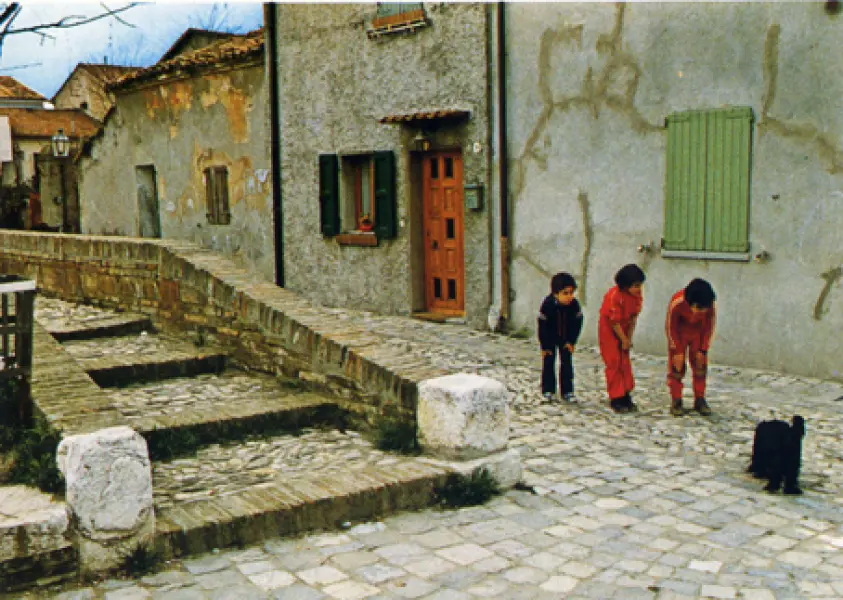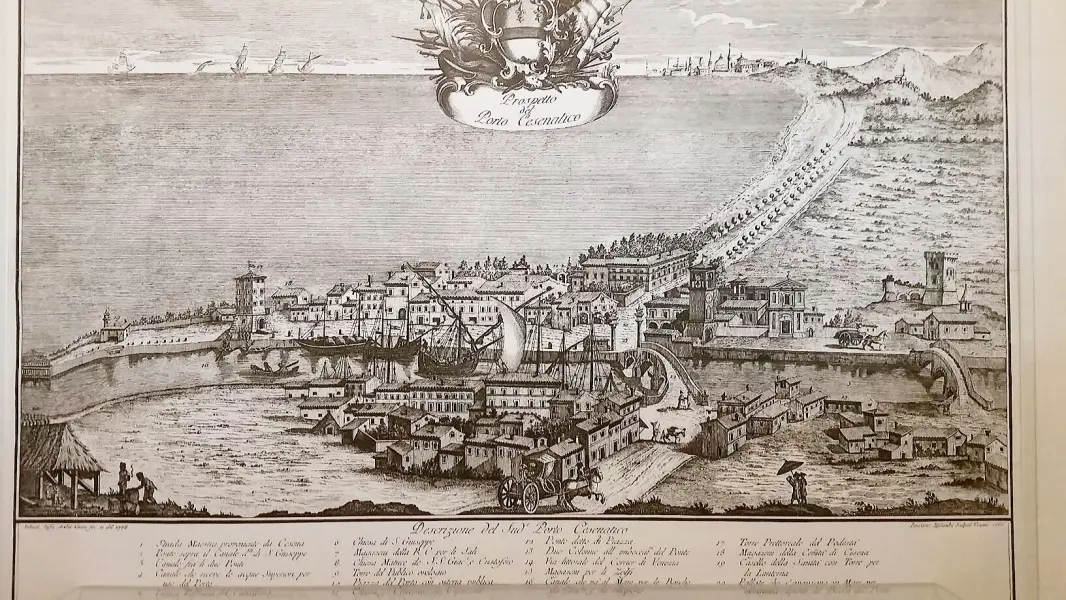Cesenatico: storia e arte
Cesenatico è una delle più importanti stazioni balneari della costa romagnola. La vivace cittadina turistica, con i suoi confortevoli alberghi e ottimi ristoranti rappresenta un'offerta particolarmente allettante per chi ama il mare e vuole concedersi una vacanza con tutta la famiglia. Ma accanto alla rinomata ospitalità romagnola e alla sua prelibata cucina, questa località merita un soggiorno anche per chi oltre al relax e al divertimento vuole concedersi anche svaghi di carattere culturale.
Romolo Liverani. Veduta di Cesenatico con la torre civica.
Acquerello eseguito prima della distruzione del 1875.
Fonte: D. Gnola, Cesenatico nella storia Edizioni Il ponte vecchio Cesena, 2008
Anche dal punto di vista storico e artistico, infatti, il piccolo centro adriatico ha molto da offrire. In base agli studi archeologici effettuati fino ad ora, gli insediamenti più antichi appartengono al periodo compreso tra il Neolitico Superiore e l'Età del bronzo, quando nella zona, ancora caratterizzato da lagune e paludi, si passa dai primi stanziamenti stagionali dei popoli dediti alla pastorizia a quelli via via più stabili. Alcuni ritrovamenti hanno infatti riportato alla luce le tracce di primitive abitazioni che erano situate nel Podere Almerici a Bagnarola di Cesenatico.

Uno dei reperti conservati presso l'Antiqyuarium di Cesenatico.
Meglio documentata è l'età romana, testimoniata dai reperti raccolti nel locale Antiquarium. Nel periodo repubblicano, nel II-I secolo a. C. il piccolo abitato di Cesenatico è indicato da alcuni ritrovamenti archeologici, e altri reperti rinvenuti nel territorio indicano la presenza di ville rustiche e fornaci particolarmente produttive durante il periodo imperiale, dal I al IV secolo d. C. A questo periodo alcuni studiosi fanno risalire Ad Novas, una località indicata da antiche fonti che doveva trovarsi in un'area comprendente Cesenatico, ma non ancora identificata.
Durante l'Alto Medioevo Cesenatico fa parte del dominio dell'Esarcato ed è soggetta alle invasioni barbariche fino al X secolo.
Nei secoli seguenti la storia di Cesenatico volge verso una fase positiva, si sviluppa intorno al suo porto e all'attività della pesca. Uno dei periodi più importanti della località romagnola è rappresentato dal medioevo, quando si configura come un vivace borgo di pescatori e punto di traffico commerciale. Nel XIV secolo Assume il nome di "porto cesenatico", cioè porto di Cesena da cui distava circa 14 chilometri.
E' in questo periodo che il nucleo abitato assume la forma ancora oggi visibile, sviluppandosi in forma lineare lungo un asse, corrispondente alla prima versione del porto canale. Tra il secolo XIII e XIV Cesenatico con il suo porto e la sua posizione geografica sulla via Francigena orientale, favoriva gli scambi commerciali tra l'entroterra romagnolo, collegato con la Toscana e con Firenze e l'Adriatico, aperto sbocco verso Venezia, i porti del sud Italia e verso est. Il '300 rappresenta per Cesenatico un momento di fioritura, poichè dai documenti storici risulta situazione economica piuttosto vivace per il piccolo centro. Infatti oltre alla tradizionale economia della pesca, era presente una salina, osterie, taverne, e strutture di accoglienza per viaggiatori e mercanti oltre alle botteghe e al mercato.

Un'immagine dell'antica Torre Pretoria di Cesenatico
Anche se dipendente dalla città di Cesena, l'importanza anche strategica del porto di Cesenatico divenne più forte, tanto da richiedere, nel 1302, la costruzione del castrum, una Rocca di difesa che venne più volte distrutta e ricostruita nel corso delle numerose vicende belliche fino al Rinascimento. Oggi la storica rocca non esiste più, ma le sue fondamenta sono state riportate alla luce e restaurate in occasione di un recente intervento archeologico. Sono visibili nel parco della Rocca situato presso la strada Statale n° 16 Adriatica.

Pietro Bastoni. Chiesa di San Giacomo Apostolo. 1763. Facciata. Cesenatico.
E' nello stesso contesto storico che si inserisce la costruzione della Chiesa sul porto canale, risalente al 1324. Inizialmente eretta come oratorio, venne dedicata ai santi Giacomo Apostolo e Cristoforo Martire, protettori dei viandanti e dei pellegrini. La Chiesa di San Giacomo esiste ancora oggi, ma è stata trasformata successiveamente in più riprese, fino alle attuali forme settecentesche. A san Giacomo, patrono di Cesenatico, dal 1325 venne dedicata anche la fiera del 25 luglio per incentivare il commercio e le attività di ristoro e ospitalità.
Durante il Rinascimento l'importanza del porto di Cesenatico crebbe soprattutto nel breve periodo della dominazione della Serenissima Repubblica di Venezia, quando il piccolo centro divenne un importante nodo di scambi internazionali, specialmente con le Fiandre e la Spagna. Risalgono al dominio veneziano le due colonne di origine greco-bizantina che sorgono sul ponte del porto-canale. Sono state erette nei primi anni del Cinquecento.
Con la conquista del territorio romagnolo da parte di Cesare Borgia con la battaglia di Agnadello nel 1509, Cesenatico entrò sotto il dominio del papa Alessandro VII. In questa occasione il Borgia ordinò la ricostruzione del porto, incaricando per il progetto Leonardo da Vinci.

Leonardo da Vinci. Rilievo del Porto di Cesenatico. 1502 ca.
Codice L. Parigi, Bibliothèque de l'Institut de France
La presenza di Leonardo a Cesenatico è documentata da alcuni disegni che il grande artista rinascimentale ha eseguito sul suo taccuino da viaggio (il celebre Codice L.) durante il suo soggiorno. Si tratta di un dettagliato rilievo del porto e di una veduta del centro abitato di Cesenatico. Entrambi i disegni sono custoditi presso La Biblioteca dell'Istituto di Francia a Parigi, mentre una copia è consultabile nella Biblioteca Comunale di Cesenatico.
La dominazione papale fu secolare, ma rappresentò un periodo di declino economico, che venne interrotto solo nel XVIII secolo con la costruzione di una strada di collegamento dalla Toscana al porto di Cesenatico per opera del granduca Pietro Leopoldo. Nonostante la modesta situazione economica, le vicende artistiche proseguono il loro corso. Appartengono a questo periodo due dipinti di Francesco Andreini, custoditi nella Chiesa parrocchiale di San Giacomo.
Altro avvenimento storico di rilievo è l'arrivo di Giuseppe Garibaldi nel 1849. All'eroe dei due mondi, la città ha dedicato una statua commemorativa risalente al 1884, tutt'ora collocata in Piazza Pisacane, vicino al porto-canale e la festa celebrata il 1° agosto.
Un altro monumento ottocentesco presente a Cesenatico è il Teatro Comunale, situato vicino al Municipio e a Casa Moretti. L'edificio di forme neoclassiche è stato progettato dall'architetto Carlo Panzani. La costruzione, voluta e finanziata dai cittadini con una pubblica sottoscrizione, risale al 1865.
Altro avvenimento, importante per lo sviluppo economico del territorio, è rappresentato dal grande lavoro di bonifica e prosciugamento delle zone umide, avviato dalla fine dell'800, su tutte le valli sub-litoranee che si estendono da Cesenatico a Goro, nel ferrarese.
Dopo l'Unità d'Italia l'economia della comunità di Cesenatico era affidata soprattutto alla pesca. In un documento del 1863 risultano 5.725 abitanti, di cui 786 indicati come pescatori. La cittadina si era organizzata anche per la conservazione del pesce tramite la costruzione delle ghiacciaie, dette anche conserve, alcune delle quali, recentemente restaurate, sono tutt'ora visibili nel centro storico.
Piazza delle conserve e la vicina Piazza delle erbe, in cui si tiene il mercato, sono due dei punti più caratteristici di Cesenatico e che mantengono l'aspetto più fedele dell'antico abitato.

Uno dei caratteristici Villini Liberty di Cesenatico.
Un momento importante di ripresa economica è invece rappresentato dalla Belle Epoque, che investì anche il piccolo centro di Cesenatico. Accanto alla locale fabbrica del ghiaccio, il cui impianto risale al 1929-30, si avviò l'industria turistica, con il diffondersi della moda dei bagni di mare e la nascita del turismo marittimo. Per quanto rappresentasse ancora un fenomeno elitaroio, riservato alle classi sociali più alte, il turismo balneare agli inizi del Novecento segnò l'avvio di una trasformazione irreversibile. Nel 1925 a Cesenatico si trovavano 24.430 turisti e nel 1933 erano già attivi 33 strutture di ospitalità, tra alberghi e pensioni. A questo periodo storico risalgono diverse costruzioni, come penzioni, alberghi, cplonie e i cosiddetti Villini Liberty, ancora conservate nel loro originale stile Liberty, presenti sul lungomare, l'attuale viale Carducci.
Al Novecento risalgono anche altri due importanti monumenti di Cesenatico: la Casa natale di Marino Moretti, che custodisce i libri e gli scritti del poeta e importante centro di studi sulla cultura novecentesca e la Colonia Agip, uno dei migliori esempi di architettura razionalista a opera di Giuseppe Vaccaro.
L'industria del turismo di Cesenatico ha avuto il massimo momento di fioritura dopo la Seconda guerra mondiale, soprattutto negli anni '60, quando le vacanze al mare sono diventate un fenomeno di massa. La proverbiale cordialità e ospitalità di questa zona hanno contribuito a mantenere fino a oggi il gradimento di migliaia di turisti.
A. Cocchi
Cesenatico Art and Hystory
Cesenatico is one of the most important seaside towns of the Romagna coast. The lively touristic town offers comfortable hotels and excellent restaurants for sea lovers who want to spend a holiday with the family. But besides the renowned hospitality from Romagna this destination is also suitable for those who, apart from relax and entertainment, want to treat themselves to some cultural time.
From the historic and artistic point of view, this small Adriatic centre has a lot to offer. Based on archaeological studies carried out to this day, the oldest places belong to the period between the New Stone Age and the Bronze Age when this area, distinguished by lagoons and swamps, went from the first seasonal settlements dedicated to sheep farming to stable more ones. Some findings have actually brought to life traces of houses in the Almerici land, in Bagnarola di Cesenatico.
The best documented period is the Roman Age, as can be seen by the findings kept in the local Antiquarian. In the Republican period (1st and 2nd centuries B.C.), some archaeological findings indicate the small populated Cesenatico, while other discoveries in the surrounding land indicate the presence of rustic houses and kilns particularly productive in the Imperial period (1st to the 4th Century A.D.). From this period, some scholars go back to the roots of Ad Novas, a location which was found around the area that now includes Cesenatico, but which was not yet identified.
During the Early Middle Ages, Cesenatico was under the power of the Exarchate and was subject to the barbaric invasions until the 10th Century. In the following centuries, the history of Cesenatico turned towards a positive way and developed around the harbour and fishing activities. One of the most important periods is the medieval when it shaped as a lively fishing village and a commercial traffic point. In the 14th Century it took on the name of "Porto Cesenatico", that is, the port of Cesena, which is 14 km away.
It is during this period that this populated centre was shaped to its current structure, developing into a linear form along an axis, correspondent to the first version of the Porto Canale (canal harbour). Between the 13th and 14th Centuries, thanks to its harbour and geographical position on via Francigena Orientale, Cesenatico promoted commercial exchanges between the back countries of Toscana and Florence, and the Adriatic coast towards Venice, the east and the south ports. The 14th Century meant a flourishing moment for Cesenatico, with a lively economic situation, according to historic documents. Besides the traditional fishing business, there was also a salt pan, a bar, a tavern, accommodation for travellers and merchants, shops and a market.
Despite being dependent of Cesena, the importance of Cesenatico's port becomes stronger, to the point of a request in 1302, for the construction of a Castrum, a fortress for defence, which was several times destroyed and rebuilt during numerous war events up to the Renaissance. Today the historic fortress doesn't exist anymore, but its foundations were uncovered and restored during recent archaeological digs. These can be seen in the Parco della Rocca, at 16, Statale Adriatica (Adriatic Road).
It is in this same historical context that the construction of the church on the canal harbour started in 1324. Initially built as an oratory, it was devoted to Saints James the Apostle and Christopher the Martyr, protectors of the wayfarers and pilgrims. The Church of San Giacomo (St. James) exists to this day, but has been changed many times until it reached the current 18th Century style. The 25th July fair has been dedicated to San Giacomo, patron saint of Cesenatico, since 1325 in order to boost the trade and the tourist business.
During the Renaissance, the importance of Cesenatico's harbour grew mainly in the short period under the Serenissima Repubblica di Venezia (Most Serene Republic of Venice) domination, when the small seaside place became an important point for international trade, mainly with Flanders and Spain. The two Byzantine Greek columns that rise above the sides of the canal bridge date back to the Venetian domination. They were erected in the first years of the 16th Century.
With the conquest of the Romagna territory by Cesare Borgia during the battle of Agnadello in 1509, Cesenatico was under the rule of Pope Alexander VII. This is when Borgia ordered the reconstruction of the harbour and asked Leonardo da Vinci to design it. The presence of Leonardo da Vinci in Cesenatico is documented in some drawings that this great Renaissance artist made on his travel notebook (the famous Codice L.) during his stay. It is a detailed relief of the port and a view of the built area of Cesenatico. Both drawings are kept in the Bibliothèque de l'Institut de France in Paris, while one copy can be consulted in the Public Library of Cesenatico.
The papal domination was secular, and represented a period of economic decline, which was interrupted only in the 18th Century, with the construction of a road linking Toscana to the harbour of Cesenatico, an initiative of the grand duke Pietro Leopoldo.
Despite the modest economic situation, the artistic events continued their course and two paintings from Francesco Andreini belong to this period. They are kept in the parish church of San Giacomo.
Another important historical event was the arrival of Giuseppe Garibaldi in 1849. The "Hero of Two Worlds", arrived in Cesenatico to embark towards Venice after defending Rome. It was at the time when he lost his loved partner Anita, who died during the night of the 2nd August. The historical episode was particularly felt by the local community and it is remembered yearly with the Festa di Garibaldi, celebrated on the first Sunday of August. The city has honoured Garibaldi with a commemorative statue dated 1884, today still standing in the Piazza Pisacane, near the canal harbour.
Another monument dated from the 19th century is the Teatro Comunale (the Municipal theatre) near the Town Hall and Casa Moretti. The neoclassic building was designed by the architect Carlo Panzani. The construction dates from 1865 and was financed by the citizens who organized a public subscription because they longed for a theatre. Another important event for the development of the territory was the land draining and reclamation works of the wet areas, started at the end of the 19th Century, on all the sub coastal valleys from Cesenatico to Goro (Ferrara).
After the unification of Italy, the economy of the Cesenatico community relied basically on fishing. A document from 1863 states that from 5,725 inhabitants, 786 were fishermen. The little town had seen also to the preservation of the fish by building some ice holes to keep the fish, also called "conserve". Some of them, recently restored, can be seen in the old town in the Piazza delle Conserve which, together the Piazza delle Erbe, is where the market takes place. They are the two most typical places of Cesenatico and keep a faithful appearance of how the old city once was.
An important moment for the economy is the Belle Époque that hit Cesenatico. Besides the local ice factory, dated from 1929-30, also the tourist industry took off, spreading the fashion of sea bathing and the birth of the seaside tourism. Even if it was an elitist phenomenon, reserved for the high society, the seaside tourism of the beginning of the 20th Century started an irreversible process. In 1925, there were 24,430 tourists in Cesenatico and in 1933 there were already 33 hotels and boarding houses. Several buildings date from this historical period, many maintained in their original Liberty style along the sea promenade, nowadays called via Carducci.
Another two important monuments date back to the 20th Century: the birth house of Marino Moretti, which keeps the books and writings of the poet and important studies about the culture of those times, and the holiday camp Agip, one of the best examples of the rationalist architecture, designed by Giuseppe Vaccaro.
The peak time for the tourism industry in Cesenatico was after the Second World War, mainly in the 60's, when sea holidays became a mass phenomenon. The proverbial cordiality and hospitability of the area helped to maintain the tourist satisfaction up to this day.
A. Cocchi.
Trad.: A. Sturmer
Bibliografia
F. Santucci, Cesenatico, da porto di Cesena a Comune Edizioni Il ponte vecchio, Cesena, 1995
D. Gnola, Storia di Cesenatico Edizioni Il ponte vecchio, Cesena, 2001
D. Gnola, Cesenatico nella storia Edizioni Il ponte vecchio Cesena, 2008
M. MARINI CALVANI (a cura di), Schede di Archeologia dell'Emilia-Romagna, Bologna 1995
B. FARFANETI, Cesenatico romana. Archeologia e territorio, Ravenna 2000



